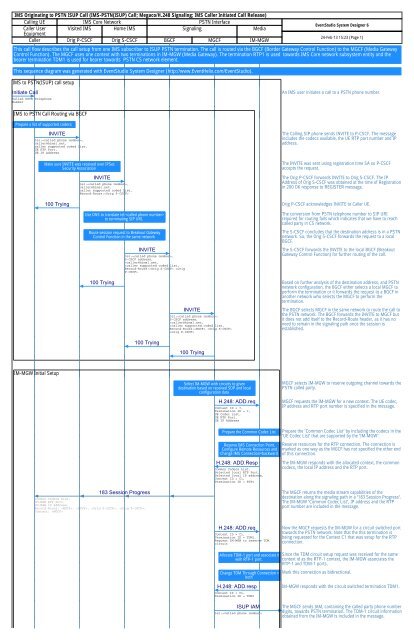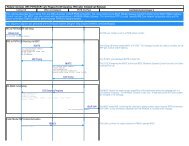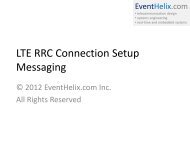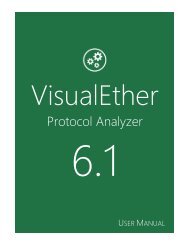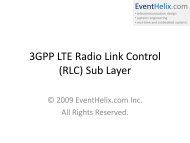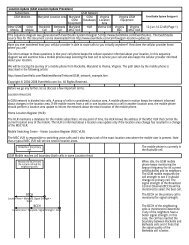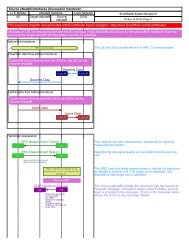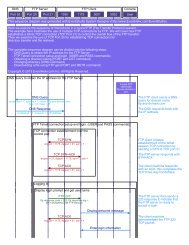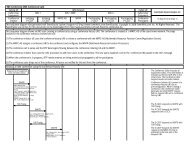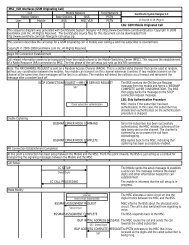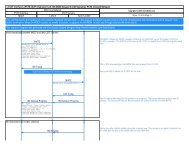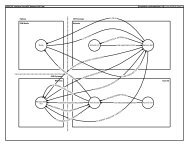IMS to PSTN Call Flow Poster - EventHelix.com
IMS to PSTN Call Flow Poster - EventHelix.com
IMS to PSTN Call Flow Poster - EventHelix.com
You also want an ePaper? Increase the reach of your titles
YUMPU automatically turns print PDFs into web optimized ePapers that Google loves.
<strong>IMS</strong> Originating <strong>to</strong> <strong>PSTN</strong> ISUP <strong>Call</strong> (<strong>IMS</strong>-<strong>PSTN</strong>(ISUP) <strong>Call</strong>; Megaco/H.248 Signaling; <strong>IMS</strong> <strong>Call</strong>er Initiated <strong>Call</strong> Release)<strong>Call</strong>ing UE <strong>IMS</strong> Core Network <strong>PSTN</strong> Interface<strong>Call</strong>er User Visited <strong>IMS</strong> Home <strong>IMS</strong> Signaling MediaEquipment<strong>Call</strong>er Orig P-CSCF Orig S-CSCF BGCF MGCF IM-MGWEventStudio System Designer 624-Feb-13 15:23 (Page 1)This call flow describes the call setup from one <strong>IMS</strong> subscriber <strong>to</strong> ISUP <strong>PSTN</strong> termination. The call is routed via the BGCF (Border Gateway Control Function) <strong>to</strong> the MGCF (Media GatewayControl Function). The MGCF uses one context with two terminations in IM-MGW (Media Gateway). The termination RTP1 is used <strong>to</strong>wards <strong>IMS</strong> Core network subsystem entity and thebearer termination TDM1 is used for bearer <strong>to</strong>wards <strong>PSTN</strong> CS network element.This sequence diagram was generated with EventStudio System Designer (http://www.<strong>EventHelix</strong>.<strong>com</strong>/EventStudio).<strong>IMS</strong> <strong>to</strong> <strong>PSTN</strong>(ISUP) call setupInitiate <strong>Call</strong><strong>Call</strong>ed <strong>PSTN</strong> TelephoneNumberAn <strong>IMS</strong> user initiates a call <strong>to</strong> a <strong>PSTN</strong> phone number.<strong>IMS</strong> <strong>to</strong> <strong>PSTN</strong> <strong>Call</strong> Routing via BGCFPrepare a list of supported codecsINVITEtel:,caller@hims1.net,caller supported coded list,UE RTP Port,UE IP AddressMake sure INVITE was received over IPSecSecurity AssociationINVITEtel:,caller@hims1.net,caller supported coded list,Record-Route:The <strong>Call</strong>ing SIP phone sends INVITE <strong>to</strong> P-CSCF. The messageincludes the codecs available, the UE RTP port number and IPaddress.The INVITE was sent using registration time SA so P-CSCFaccepts the request.The Orig P-CSCF forwards INVITE <strong>to</strong> Orig S-CSCF. The IPAddress of Orig S-CSCF was obtained at the time of Registrationin 200 OK response <strong>to</strong> REGISTER message.100 Trying Orig P-CSCF acknowledges INVITE <strong>to</strong> <strong>Call</strong>er UE.Use DNS <strong>to</strong> translate tel:<strong>to</strong> terminating SIP URI.Route session request <strong>to</strong> Breakout GatewayControl Function in the same networkINVITEtel:,S-CSCF address,
<strong>IMS</strong> Originating <strong>to</strong> <strong>PSTN</strong> ISUP <strong>Call</strong> (<strong>IMS</strong>-<strong>PSTN</strong>(ISUP) <strong>Call</strong>; Megaco/H.248 Signaling; <strong>IMS</strong> <strong>Call</strong>er Initiated <strong>Call</strong> Release)<strong>Call</strong>ing UE <strong>IMS</strong> Core Network <strong>PSTN</strong> Interface<strong>Call</strong>er User Visited <strong>IMS</strong> Home <strong>IMS</strong> Signaling MediaEquipment<strong>Call</strong>er Orig P-CSCF Orig S-CSCF BGCF MGCF IM-MGWEventStudio System Designer 624-Feb-13 15:23 (Page 2)<strong>Call</strong>er Media PDP Context ActivationSelect the Codec indicated in 183Session ProgressSelected CodecPRACKThe <strong>Call</strong>er confirms the codec selection in PRACK <strong>to</strong>wardsMGCF.begin<strong>Call</strong>er PDP Context ActivationH.248: MOD.reqContext = C1,Termination = RTP1,Selected CodecThe MGCF modifies the IM-MGW context <strong>to</strong> update the IM-MGWabout the codec selected for the RTP session.Configure <strong>IMS</strong> resourcesH.248: MOD.respContext = C1,Termination = RTP1IM-MGW responds back.Selected Codec,Selected UDP Port,Selected IP Address200 OK (PRACK)The codec selected is acknowledged <strong>to</strong> the UE.end<strong>Call</strong>er PDP Context ActivationUPDATESince caller PDP Context Activation is over, notify the called endin UPDATE message.200 OK (UPDATE) The called end replies back with 200 OK.ISUP COTBased on the continuity support of the outgoing channelselected MGCF sends a COT message <strong>to</strong> the <strong>PSTN</strong> network.RingingISUP ACMThe path <strong>to</strong>wards the called party is allocated in the <strong>PSTN</strong>network and address <strong>com</strong>plete message, ACM containingsubscriber free indication is sent <strong>to</strong> MGCF. The ACM messagealso indicates that the called party in the <strong>PSTN</strong> network is beingalerted.180 Ringing The MGCF forwards called party alerting indication in 180ringing message <strong>to</strong>wards the <strong>Call</strong>er.Ring BacRTP: Ring Back TonePRACKRing BacThe ring back <strong>to</strong>ne is fed <strong>to</strong> the calling subscriber. The IM-MGWconverts the <strong>to</strong>ne in<strong>to</strong> RTP. The UE converts it back <strong>to</strong> the ringback <strong>to</strong>ne and feeds it <strong>to</strong> the calling subscriber.The <strong>Call</strong>er acknowledges the 180 ringing with PRACK message<strong>to</strong>wards MGCF.200 OK (PRACK) The MGCF acknowledges the PRACK message with 200 OKmessage.Conversation ModeISUP ANMH.248: MOD.reqContext ID = C1,Termination ID = RTP1When the called party answers, the terminating <strong>PSTN</strong> networksends answer, ANM message <strong>to</strong>wards MGCF.Request a bidirectional through connectionChange <strong>IMS</strong> Through Connection =bothH.248: MOD.respContext ID = C1,Termination ID = RTP1H.248: MOD.reqContext ID = C1,Termination ID = TDM1Request activation of TDM voice processing function.Activate TDM Voice ProcessingFunctionH.248: MOD.respContext ID = C1,Termination ID = TDM1200 OK (INVITE) The final response, 200 OK, is sent by the MGCF over thesignaling path when the subscriber has accepted the in<strong>com</strong>ingsession attempt.ACKThe <strong>Call</strong>er sends the final acknowledgement in ACK message<strong>to</strong>wards MGCF.VoiceRTP: VoiceVoiceBidirectional voice path is now through. The IM-MGW convertsRTP <strong>to</strong> voice and vice versa. UE also maps audio <strong>to</strong> RTP andback.BYEThe <strong>Call</strong>er sends BYE <strong>to</strong>wards MGCF when the calling partyhangs up.Drop media PDP context200 OK (BYE) The MGCF acknowledges with 200 OK message <strong>to</strong>wards <strong>Call</strong>er.
<strong>IMS</strong> Originating <strong>to</strong> <strong>PSTN</strong> ISUP <strong>Call</strong> (<strong>IMS</strong>-<strong>PSTN</strong>(ISUP) <strong>Call</strong>; Megaco/H.248 Signaling; <strong>IMS</strong> <strong>Call</strong>er Initiated <strong>Call</strong> Release)<strong>Call</strong>ing UE <strong>IMS</strong> Core Network <strong>PSTN</strong> Interface<strong>Call</strong>er User Visited <strong>IMS</strong> Home <strong>IMS</strong> Signaling MediaEquipment<strong>Call</strong>er Orig P-CSCF Orig S-CSCF BGCF MGCF IM-MGWRelease <strong>IMS</strong> TerminationISUP RELH.248: SUB.reqContext ID = C1,Termination ID = RTP1EventStudio System Designer 624-Feb-13 15:23 (Page 3)The MGCF initiates call release in the <strong>PSTN</strong> network by sendingISUP REL message.MGCF requests IM-MGW <strong>to</strong> release RTP1 resource.H.248: SUB.respContext ID = C1,Termination ID = RTP1Release TDM TerminationMGCF requests IM-MGW <strong>to</strong> release TDM1 resource.H.248: SUB.reqContext ID = C1,Termination ID = TDM1H.248: SUB.respContext ID = C1,Termination ID = TDM1ISUP RLCThis sequence diagram was generated with EventStudio System Designer (http://www.<strong>EventHelix</strong>.<strong>com</strong>/EventStudio).The <strong>PSTN</strong> network acknowledges the call release with ISUPRLC, release <strong>com</strong>plete <strong>to</strong>wards MGCF.
<strong>IMS</strong> Originating <strong>to</strong> <strong>PSTN</strong> ISUP <strong>Call</strong> (<strong>Call</strong>ed <strong>PSTN</strong> Subscriber Initiates Release)<strong>Call</strong>ing UE <strong>IMS</strong> Core Network <strong>PSTN</strong> Interface<strong>Call</strong>er User Visited <strong>IMS</strong> Home <strong>IMS</strong> Signaling MediaEquipment<strong>Call</strong>er Orig P-CSCF Orig S-CSCF BGCF MGCF IM-MGWEventStudio System Designer 624-Feb-13 15:23 (Page 4)This call flow describes the call setup from one <strong>IMS</strong> subscriber <strong>to</strong> ISUP <strong>PSTN</strong> termination. The call is routed via the BGCF (Border Gateway Control Function) <strong>to</strong> the MGCF (Media GatewayControl Function). The MGCF uses one context with two terminations in IM-MGW (Media Gateway). The termination RTP1 is used <strong>to</strong>wards <strong>IMS</strong> Core network subsystem entity and thebearer termination TDM1 is used for bearer <strong>to</strong>wards <strong>PSTN</strong> CS network element.This sequence diagram was generated with EventStudio System Designer (http://www.<strong>EventHelix</strong>.<strong>com</strong>/EventStudio).<strong>IMS</strong> <strong>to</strong> <strong>PSTN</strong>(ISUP) call setupVoiceRTP: VoiceVoiceBidirectional voice path is now through. The IM-MGW convertsRTP <strong>to</strong> voice and vice versa. UE also maps audio <strong>to</strong> RTP andback.ISUP RELThe call release initiated in the <strong>PSTN</strong> network is received byMGCF is ISUP REL message.BYEThe MGCF responds with call release by sending BYE message<strong>to</strong>wards the <strong>Call</strong>er.Release <strong>IMS</strong> TerminationMGCF requests IM-MGW <strong>to</strong> release RTP1 resource.H.248: SUB.reqContext ID = C1,Termination ID = RTP1H.248: SUB.respContext ID = C1,Termination ID = RTP1Release TDM TerminationMGCF requests IM-MGW <strong>to</strong> release TDM1 resource.H.248: SUB.reqContext ID = C1,Termination ID = TDM1H.248: SUB.respContext ID = C1,Termination ID = TDM1ISUP RLCAfter performing RTP1 and TDM1 resource release, MGCF sendsrelease <strong>com</strong>plete message, ISUP RLC <strong>to</strong>wards the <strong>PSTN</strong>network.Drop media PDP context200 OK (BYE) The <strong>Call</strong>er acknowledges the BYE by sending 200 OK <strong>to</strong>wardsMGCF.This sequence diagram was generated with EventStudio System Designer (http://www.<strong>EventHelix</strong>.<strong>com</strong>/EventStudio).
<strong>IMS</strong> Originating <strong>to</strong> <strong>PSTN</strong> ISUP <strong>Call</strong> (<strong>IMS</strong> Network Initiates <strong>Call</strong> Release)<strong>Call</strong>ing UE <strong>IMS</strong> Core Network <strong>PSTN</strong> Interface<strong>Call</strong>er User Visited <strong>IMS</strong> Home <strong>IMS</strong> Signaling MediaEquipment<strong>Call</strong>er Orig P-CSCF Orig S-CSCF BGCF MGCF IM-MGWEventStudio System Designer 624-Feb-13 15:23 (Page 5)This call flow describes the call setup from one <strong>IMS</strong> subscriber <strong>to</strong> ISUP <strong>PSTN</strong> termination. The call is routed via the BGCF (Border Gateway Control Function) <strong>to</strong> the MGCF (Media GatewayControl Function). The MGCF uses one context with two terminations in IM-MGW (Media Gateway). The termination RTP1 is used <strong>to</strong>wards <strong>IMS</strong> Core network subsystem entity and thebearer termination TDM1 is used for bearer <strong>to</strong>wards <strong>PSTN</strong> CS network element.This sequence diagram was generated with EventStudio System Designer (http://www.<strong>EventHelix</strong>.<strong>com</strong>/EventStudio).<strong>IMS</strong> <strong>to</strong> <strong>PSTN</strong>(ISUP) call setupVoiceRTP: VoiceVoiceBidirectional voice path is now through. The IM-MGW convertsRTP <strong>to</strong> voice and vice versa. UE also maps audio <strong>to</strong> RTP andback.BYE BYEBYE The Orig S-CSCF initiates call release by sending BYE <strong>to</strong>wardsMGCF and the <strong>Call</strong>er.Drop media PDP context200 OK (BYE) 200 OK (BYE)200 OK (BYE)Release <strong>IMS</strong> TerminationISUP RELH.248: SUB.reqContext ID = C1,Termination ID = RTP1H.248: SUB.respContext ID = C1,Termination ID = RTP1Release TDM TerminationH.248: SUB.reqContext ID = C1,Termination ID = TDM1H.248: SUB.respContext ID = C1,Termination ID = TDM1The MGCF initiates call release in the <strong>PSTN</strong> network by sendingISUP REL message.MGCF requests IM-MGW <strong>to</strong> release RTP1 resource.MGCF requests IM-MGW <strong>to</strong> release TDM1 resource.ISUP RLCThis sequence diagram was generated with EventStudio System Designer (http://www.<strong>EventHelix</strong>.<strong>com</strong>/EventStudio).The <strong>PSTN</strong> network acknowledges the call release with ISUPRLC, release <strong>com</strong>plete <strong>to</strong>wards MGCF.
<strong>IMS</strong> Originating <strong>to</strong> <strong>PSTN</strong> ISUP <strong>Call</strong> (MGCF Initiated <strong>Call</strong> Release)<strong>Call</strong>ing UE <strong>IMS</strong> Core Network <strong>PSTN</strong> Interface<strong>Call</strong>er User Visited <strong>IMS</strong> Home <strong>IMS</strong> Signaling MediaEquipment<strong>Call</strong>er Orig P-CSCF Orig S-CSCF BGCF MGCF IM-MGWEventStudio System Designer 624-Feb-13 15:23 (Page 6)This call flow describes the call setup from one <strong>IMS</strong> subscriber <strong>to</strong> ISUP <strong>PSTN</strong> termination. The call is routed via the BGCF (Border Gateway Control Function) <strong>to</strong> the MGCF (Media GatewayControl Function). The MGCF uses one context with two terminations in IM-MGW (Media Gateway). The termination RTP1 is used <strong>to</strong>wards <strong>IMS</strong> Core network subsystem entity and thebearer termination TDM1 is used for bearer <strong>to</strong>wards <strong>PSTN</strong> CS network element.This sequence diagram was generated with EventStudio System Designer (http://www.<strong>EventHelix</strong>.<strong>com</strong>/EventStudio).<strong>IMS</strong> <strong>to</strong> <strong>PSTN</strong>(ISUP) call setupVoiceRTP: VoiceVoiceBidirectional voice path is now through. The IM-MGW convertsRTP <strong>to</strong> voice and vice versa. UE also maps audio <strong>to</strong> RTP andback.BYEThe MGCF initiates the call release by sending BYE <strong>to</strong>wards the<strong>Call</strong>er.Release <strong>IMS</strong> TerminationISUP RELH.248: SUB.reqContext ID = C1,Termination ID = RTP1The MGCF initiates call release in the <strong>PSTN</strong> network by sendingISUP REL message.MGCF requests IM-MGW <strong>to</strong> release RTP1 resource.H.248: SUB.respContext ID = C1,Termination ID = RTP1Release TDM TerminationMGCF requests IM-MGW <strong>to</strong> release TDM1 resource.H.248: SUB.reqContext ID = C1,Termination ID = TDM1H.248: SUB.respContext ID = C1,Termination ID = TDM1ISUP RLCThe <strong>PSTN</strong> network acknowledges the call release with ISUPRLC, release <strong>com</strong>plete <strong>to</strong>wards MGCF.Drop media PDP context200 OK (BYE) The <strong>Call</strong>er acknowledges the BYE message with 200 OK <strong>to</strong>wardsMGCF.This sequence diagram was generated with EventStudio System Designer (http://www.<strong>EventHelix</strong>.<strong>com</strong>/EventStudio).


